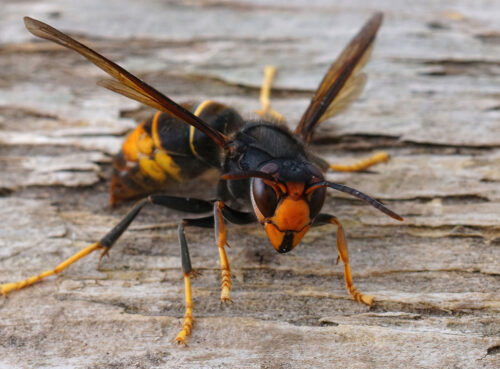Yellow Legged Hornet
 The Yellow Legged Hornet, also known as the Asian Hornet, was accidentally introduced into Europe from its native Asia in around 2004. It is an invasive, non-native species and poses a threat to our natural population of honey bees and other species of insect pollinators. It is understood that Yellow Legged Hornets are able to eat up to 50 honey bees per day.
The Yellow Legged Hornet, also known as the Asian Hornet, was accidentally introduced into Europe from its native Asia in around 2004. It is an invasive, non-native species and poses a threat to our natural population of honey bees and other species of insect pollinators. It is understood that Yellow Legged Hornets are able to eat up to 50 honey bees per day.
If you think you have seen a Yellow Legged Hornet, you must try and take a clear photograph of it safely and report it to the Biological Records Centre:
Biological Records Centre UK
You can also find out more about the Yellow Legged Hornet here:
National Bee Unit
To see more up to date information around confirmed sightings in the UK in 2025, please visit:
2025 rolling update page
For those of you using your Gard ‘Apis traps, you should now be using the orange end cones, as this is the entrance that captures the worker yellow legged hornets.
If you have run out of lure/bait the use of watered-down jam works just as well, any flavour will do. It has been decided that beer, cider, or other alcoholic drink also will work, but that seems rather wasteful. Basically, anything that attracts wasps will attract YLH. If you are going to be checking your traps, I would like to invite you to participate in the eR2 monitoring for the months or April and May. This is not yet a high-risk area, hence only the two months has been suggested until recommencement in Autumn unless you want to record your traps throughout the summer.
The App has also been modified since last year to be more user friendly, gives the option to pause it when you feel that you want a break, and no longer sends out automatic chase up emails, which I know were a source of annoyance and put those who participated off continuing. I would encourage you all to participate, as the more that do, the better recorded data collected by eR2 will be regarding the whereabouts of the YLH.
If you do decide to participate, could you please provide me with your email and area post code that you hang your trap/traps in so that I can add you to the system. If you were one of those who participated last year could you let me know if you are willing to continue and the area that you covered.
If anyone wonders why the name change it was because the term Asian Hornet was apparently considered to include all hornets that came from Asia. I would also like to remind anyone that has downloaded the Asian Hornet App, the name remains the same, that photos are required to verify the report, as Defra are now taking the stance no photo, no action. This is mainly since there were over 29,000 reported sightings in 2024, but only 71 were YLH, 0.2% of all sightings. Of the 19 queens caught last May, 9 were from the Four Oak nests showing that they travel about 5 miles from the original nests so they are slowly heading this way.
I would recommend those that haven’t downloaded the Asian Hornet App to do so even if you are not interested in participating in the official monitoring via eR2 . You can download the App via play store or the google store